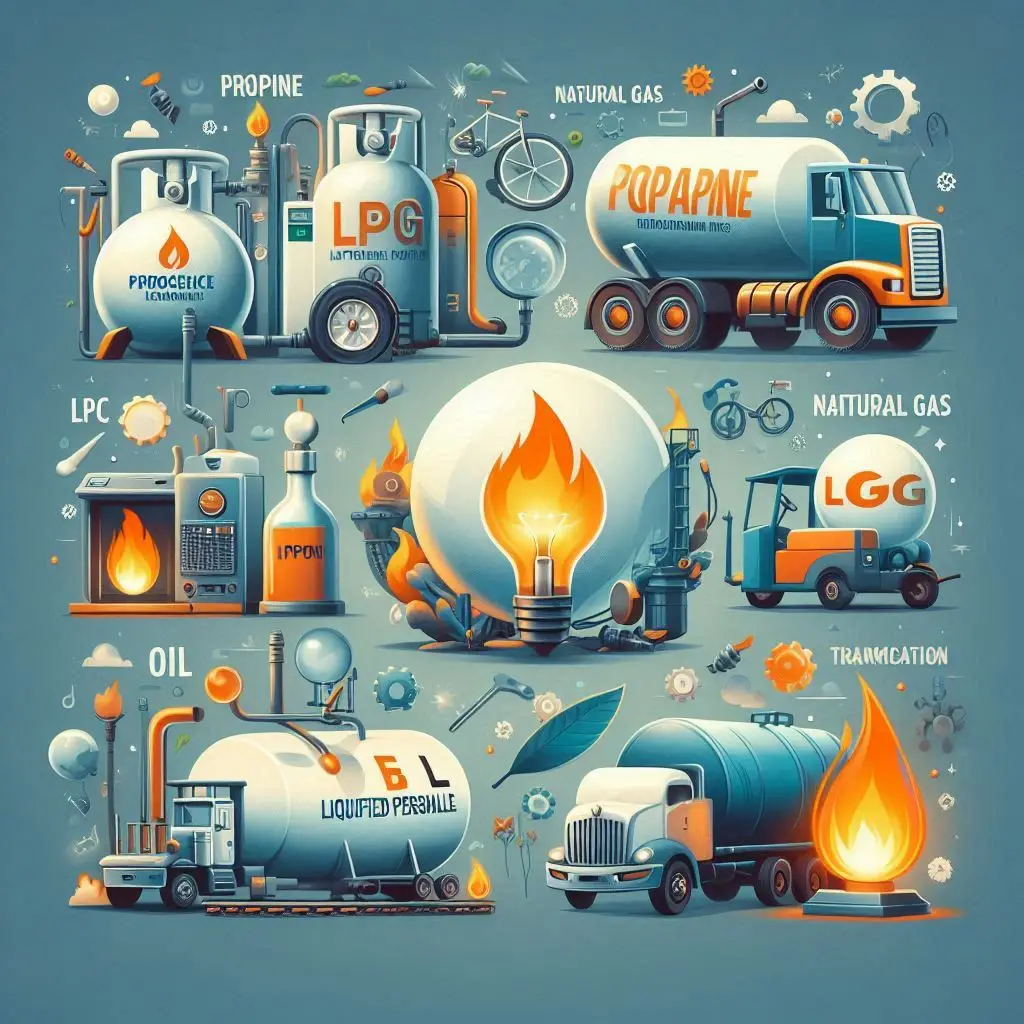
Propane vs LPG vs Natural Gas vs LP vs Oil
Introduction
This article, Propane vs LPG vs Natural Gas vs LP vs Oil, explores these energy sources in detail, comparing propane, LPG, natural gas, LP, and oil to highlight their unique attributes and applications.
Energy sources are pivotal in our daily lives, powering homes, industries, and transportation. Among the various options available, propane, liquefied petroleum gas (LPG), natural gas, liquefied petroleum (LP), and oil stand out as the most prominent. Each of these energy sources has distinct characteristics, uses, and benefits. Understanding their differences and similarities can help consumers make informed choices about their energy needs.
Propane vs LPG vs Natural Gas
Propane and LPG are often used interchangeably, but their key differences exist. Propane is a specific type of LPG, which includes other gases such as butane and isobutane. Propane is the most commonly used LPG due to its versatility and availability. It is a byproduct of natural gas processing and petroleum refining, making it a popular choice for heating, cooking, and powering appliances in areas without natural gas pipelines.
LPG, on the other hand, is a broader term encompassing various hydrocarbons. LPG is stored in liquid form under pressure and is used for heating, cooking, and fuel for vehicles. It is also utilized in industrial applications due to its high energy content and efficiency.
Natural gas, primarily composed of methane, is another widely used energy source. It is extracted from underground reservoirs and delivered to consumers through pipelines. Natural gas is known for its clean-burning properties, making it an environmentally friendly option. It is commonly used for heating, electricity generation, and as a fuel for vehicles.
When comparing propane, LPG, and natural gas, the key differences lie in their composition, storage, and delivery methods. Propane and LPG are stored in liquid form under pressure, while natural gas is delivered through pipelines in its gaseous state. This difference impacts their usage, with propane and LPG being more suitable for areas without pipeline infrastructure, while natural gas is preferred in regions with established pipeline networks.
LP vs Propane vs Natural Gas
The term "LP" is often used interchangeably with LPG, but it is essential to understand its specific context. LP stands for liquefied petroleum, which includes propane and other hydrocarbons. In practical usage, LP and propane are nearly synonymous, especially in the context of residential and commercial applications.
As mentioned earlier, propane is a type of LPG used extensively for heating, cooking, and fuel for vehicles. Its portability and ease of storage make it a popular choice in rural and remote areas. Propane is stored in tanks and can be transported easily, providing a reliable energy source where natural gas pipelines are unavailable.
Natural gas, in contrast, requires an extensive pipeline infrastructure for delivery. This makes it more suitable for urban and suburban areas with established networks. Natural gas is often preferred for its lower cost and environmental benefits. It produces fewer greenhouse gases compared to other fossil fuels, making it a cleaner option for heating and electricity generation.
When comparing LP, propane, and natural gas, the primary considerations are availability, cost, and environmental impact. Propane and LP offer flexibility and portability, making them ideal for areas without natural gas pipelines. Natural gas, however, is often more economical and environmentally friendly, provided there is access to the necessary infrastructure.
Propane vs Natural Gas vs Oil
Propane, natural gas, and oil are three major energy sources used for heating and fuel. Each has distinct advantages and disadvantages, influencing consumer choice based on factors such as cost, availability, and environmental impact.
Propane, as discussed, is a versatile fuel used for heating, cooking, and powering vehicles. Its portability makes it ideal for rural areas without natural gas pipelines. Propane burns cleaner than oil, producing fewer pollutants and greenhouse gases. This environmental benefit, coupled with its efficiency, makes propane a preferred choice for many consumers.
Natural gas is commonly used to generate energy and heat. In both urban and suburban settings, its cost-effectiveness and clean-burning qualities make it a popular option. Natural gas has a smaller carbon footprint than propane and oil because it emits less emissions. However, its availability in rural places is limited because to the need for a vast pipeline network.
Oil, primarily used for heating, has been a traditional energy source for many years. It is stored in large tanks and delivered by truck, making it accessible in areas without natural gas pipelines. However, oil is less efficient and produces more emissions compared to propane and natural gas. The environmental impact of oil, coupled with fluctuating prices, has led to a decline in its popularity.
When comparing propane, natural gas, and oil, the choice often comes down to availability and environmental considerations. Propane and natural gas are cleaner and more efficient, making them preferable for reducing carbon footprints. Oil remains an option in areas where other energy sources are not readily available, but its environmental impact and cost make it a less attractive choice.
Conclusion
In conclusion, the comparison between propane, LPG, natural gas, LP, and oil highlights the unique characteristics and benefits of each energy source. Propane and LPG offer versatility and portability, making them ideal for areas without natural gas pipelines. Natural gas stands out for its clean-burning properties and cost-effectiveness, particularly in regions with established pipeline networks. Oil, while still used in some areas, faces challenges due to its environmental impact and fluctuating prices.
Understanding these differences enables consumers to make informed decisions based on their specific needs, availability of infrastructure, and environmental considerations. As the energy landscape continues to evolve, the importance of choosing efficient and sustainable energy sources becomes increasingly significant. By carefully evaluating the pros and cons of propane, LPG, natural gas, LP, and oil, consumers can contribute to a cleaner and more sustainable future.

